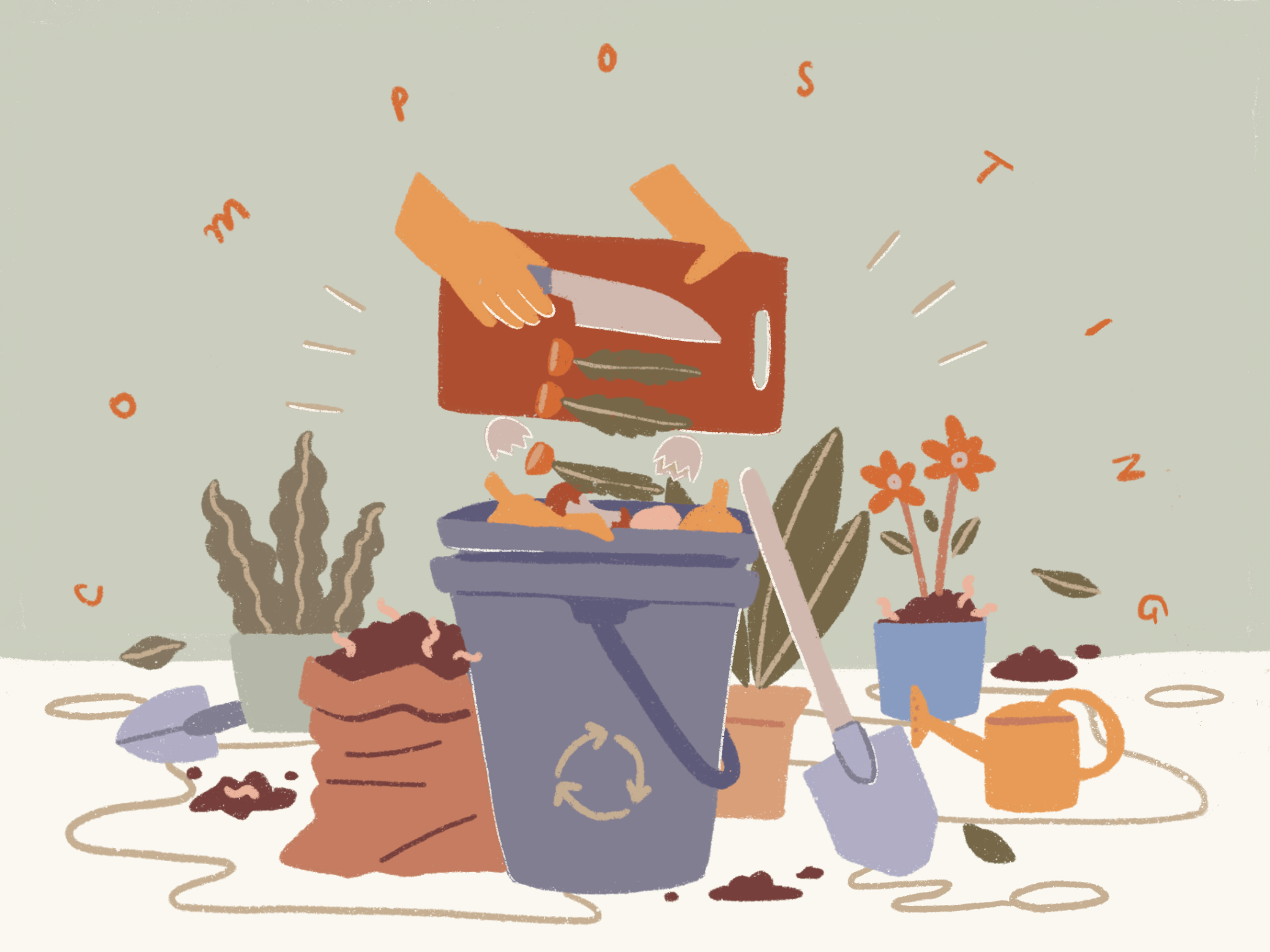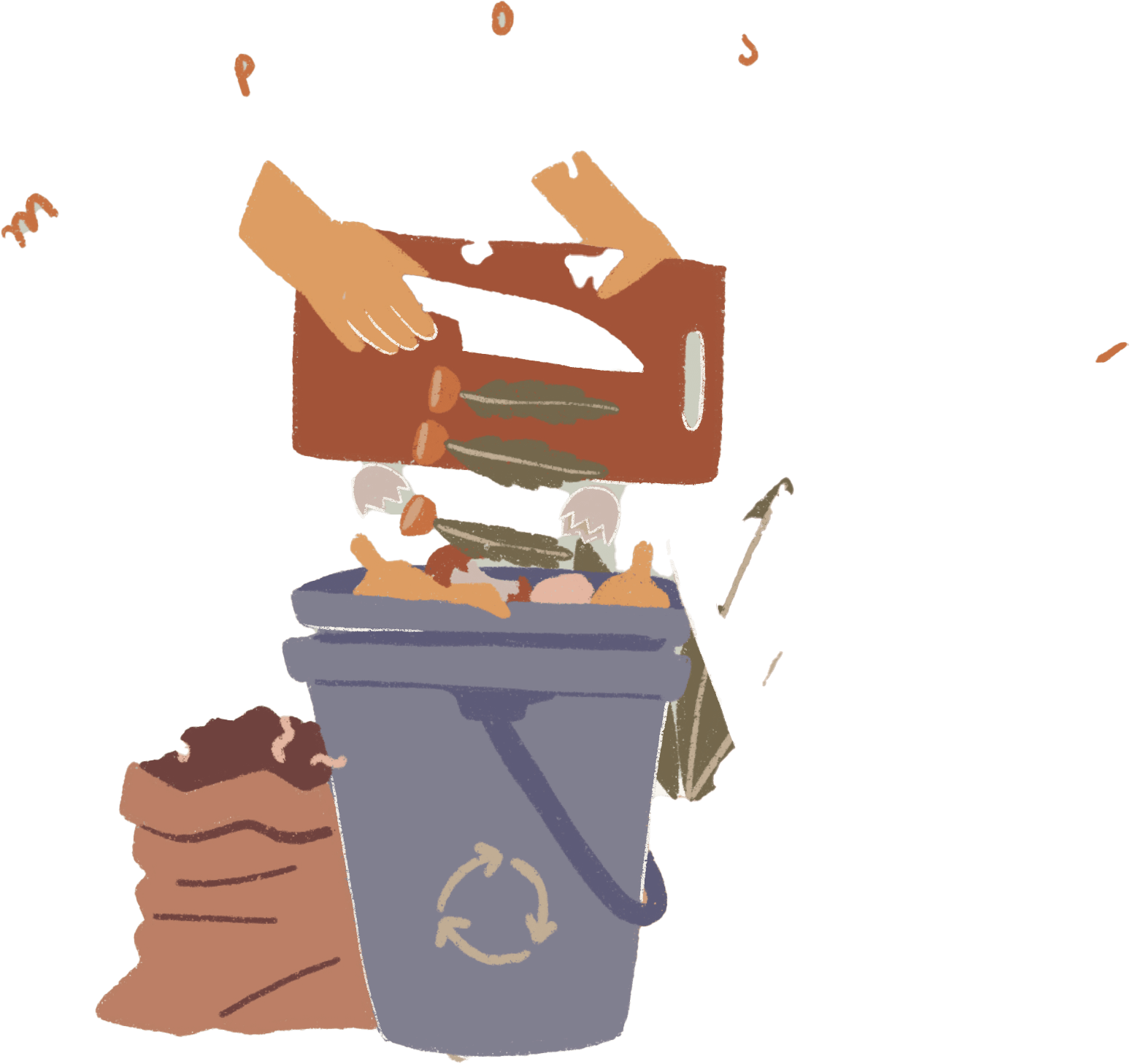
Illustrated by Himanshi Parmar
What is Composting?
Composting is the ultimate recycling system in nature. It is a natural process where the organic matter gets broken down into granular matter humus called compost, which can then be used as a nourishing soil amendment. Beneficial organisms including bacteria, fungi, insects, and worms help transform the organic matter into a rich, dark, crumbly nutrient-heavy substance that can be added to the soil.
Composting creates an ideal environment that can transform decomposing organic matter, saving it from becoming ‘waste’. It is often called ‘black gold’ because of how rich it is in nutrients, a true natural fertilizer!
This process can be termed upcycling: transforming a waste product into something useful and of quality. It is part of the cyclical nature of life: birth, growth, death, decay, and nourishment back into the earth.
.png)
Why compost?
According to the USDA, food waste contributes to 30-40% of the food supply in the United States. Food is the biggest contributor to landfill waste.
If not given the correct conditions of composting, food sitting in a landfill can become toxic and release methane, a harmful greenhouse gas that pollutes our air and water systems.
.png)
Home composting is one of the ways for individuals to contribute towards a more sustainable planet by reducing waste and one’s carbon footprint. The other benefits of composting are:
- Reduces the need for chemical fertilizers which are very harmful to our water systems
- Improves the quality and health of the soil
- Improves the yield and quality of your plants
- Introduces valuable organisms to the soil
- Prevents soil erosion
How to compost?
There are a few different ways to home compost, including one that is often called aerobic, passive, or cool composting. It is the easiest, least labor-intensive method. This process of home composting lets nature take its course, and all you must do is provide the correct environment.
Before we start, let’s educate ourselves on a few basics. There are two categories of what you can and should compost:
Greens (Nitrogen rich materials):
- Raw Vegetable/ Fruit waste
- Old vegetables
- Grass cuttings
- Plants
- Tea (removed from the tea bags unless the tea bags are 100% compostable)
- Coffee Grounds
- Nuts
- Leaves
- Eggshells
Browns (Carbon-rich materials):
- Dried leaves
- Cardboard
- Toilet roll middles
- Straw
- Hay
- Egg boxes
- Wastepaper (though be careful about the ink as that could be toxic)
.png)
What not to compost:
- Dairy
- Meat, fish eggs
- Cooked food
- Oil, lard, fats
- Processed food
- Unnatural products that are not biodegradable or may take years to break down
Compost in moderation
- Citrus peels (as the acid might kill the healthy microorganisms in the pile)
- Biodegradable paper and “natural” packaging etc. It may take forever to break down. It will need a more industrial-level composting system that may be available in your city/town.
.png)
Tips:
- Composting needs the correct balance of greens and browns. The greens will make the compost wet and the browns will dry it out. You would like your compost moist but not wet. A drier compost will take longer to break down, while a wet compost might get smelly and promote toxicity. Work out the balance as you keep adding new material. Your compost should always smell pleasant of the earth, not of rotting food.
- Air is essential for your compost. Some of the ways you can introduce air are by turning your compost or layering green and brown and creating space, so things are not clumped together.
- When collecting your kitchen waste, do not let it sit together for too long and start decomposing. Transfer it into the compost pile as soon as possible.
- When in doubt, ask the internet! Don’t be shy to ask for help and ask questions.
What is needed for composting?
- A container/dedicated area
- Greens (nitrogen-rich materials)
- Browns (carbon-rich materials)
- Microorganisms / Organisms
- Air
- Starter- Soil/ Kombucha/ Vinegar work as good starters to introduce microorganisms in your compost. You only need to add it in the beginning.

Step 1: Get yourself a compost bin, a tumbler [1], or any large bin that can be accommodated in the space you have. You can even make one yourself. You need to always cover the bin to ensure the environment inside is least exposed.
Step 2: Gather your greens and browns
Step 3: Mix it up together in your compost bin
Step 4: Add some soil or any other starter you wish to use.
Step 5: Cover the lid and let nature do its work
Step 6: Aerate your compost regularly
Step 7: Keep adding greens and browns in the correct proportion
When is the compost ready?
Once your pile feels, smells, and looks like mud and you can't see the remnants of what you have composted, it is ready! However, it is best left to mature for a month or two before you start using it. You can put the compost in another container to mature and continue composting in your first bin.
What to do with the compost?
- Add to the soil of potted plants
- Add to the soil of your garden around the trees
- Make compost tea and water your plants
- Give some to your friends that have gardens / share it with your community / offer it to garden centers
.png)
Here are some great resources to help you on your composting journey:
https://learn.eartheasy.com/guides/composting/
https://www.epa.gov/recycle/composting-home
The term ‘waste’ means something that has no purpose anymore or is harmful. Through the process of composting, we are taking what could be waste and transforming it into an invaluable resource.
Happy composting everyone! Share your composting journeys with us below!